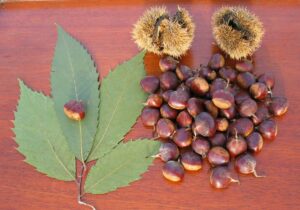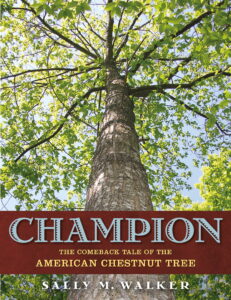By Annie Reid, Contributing Writer

Photo/Timoth Van Vliet (CC BY-SA 3.0)
Due to progress in science and technology, it’s time for an update on efforts to bring back the American chestnut (Castanea dentata). This magnificent tree dominated hardwood forests in eastern North America when Europeans first arrived five hundred years ago. Then, in the 20th century, the tree was largely lost to the chestnut blight fungus (Cryphonectria parasitica) in only 50 years (1904-1950s).
You can still find a few reminders of the once mighty chestnut tree in our area. Beams of chestnut wood still exist in attics or basements of some homes and barns built before 1904 (when the blight arrived). In the woods today, American chestnut saplings continue to sprout from the living roots of long-gone trees. Most become infected with the blight and die before maturity. Look for these saplings next to trails in the woods. Chestnut leaves are long and narrow (about 5-8 inches long and 1.5-3.5 inches wide) with a pointed tip and pointed triangular teeth on the edges. These leaves turn yellow and then brown in autumn.
Recent science has brought a new approach to restoring the American chestnut. You probably won’t be surprised that it involves genetics. This approach involves adding to the American chestnut tree a single new gene (OXO) that enables the tree to survive infection with the blight fungus. The resulting trees, and most of their offspring, are able to live – to coexist – with the blight.
Here are some details. When the blight fungus infects an American chestnut tree, the fungus releases large quantities of oxalic acid (sometimes called oxalate), which kills tissues of the tree. The oxalic acid causes the canker, blistering, and eventual girdling of the infected tree, leading to the tree’s death. The added gene produces an enzyme (basically a protein called oxalate oxidase, OXO) that breaks down oxalic acid. As a result, trees with the gene survive when infected and live on.
The trees with the OXO gene are known as Darling 58 American Chestnuts (named after Herb Darling of The American Chestnut Foundation). They originated when the OXO gene, which comes from wheat, was added to an American chestnut embryo. Now there’s a whole line of these trees. Their response to the blight has been tested experimentally to see how they survive. They are being studied extensively. They’re also being bred experimentally with one another, as well as with Chinese, Japanese and European chestnut trees. These other chestnut species evolved their own forms of blight resistance, over thousands of years of living alongside the blight fungus, which existed in Asia and Europe (but not North America until 1904).
In collaboration with the State University of New York (SUNY) College of Environmental Science and Forestry (ESF), the nonprofit American Chestnut Foundation (TACF), founded in 1983, is spearheading the project to restore the American chestnut to the eastern North American forests where it formerly grew.
Prior to recent work with genetics that produced the Darling 58 American Chestnut, research had focused on selective breeding. This effort involved crossing American chestnuts with blight-resistant Chinese chestnuts (Castanea mollissima). The goal was to create hybrid trees with the characteristics of American chestnuts and the blight resistance of Chinese chestnuts. After breeding seven generations to get seedlings that were 15/16 (94 percent) American chestnut and 1/16 Chinese chestnut, researchers found the results less promising than they’d hoped. What happened? The Chinese chestnut’s blight resistance came from up to nine genes and became too diluted to work effectively.
Yet another line of research pursues the possibility of fighting the blight fungus with a virus. It has not yet worked out. It did, however, yield knowledge about the role of oxalic acid in infecting a tree.
What now is the future of the American chestnut? It remains to be seen. Federal agencies such as the U.S. Department of Agriculture (USDA) are scrutinizing Darling 58 to see if it can be released into the wild.
 Interested in more about the American chestnut’s story? Read the book, “Champion: The Comeback Tale of the American Chestnut Tree” by Sally M. Walker. It’s informative and interesting for both young people and adults.
Interested in more about the American chestnut’s story? Read the book, “Champion: The Comeback Tale of the American Chestnut Tree” by Sally M. Walker. It’s informative and interesting for both young people and adults.
Check out the American Chestnut Foundation website https://acf.org and the SUNY ESF website https://www.esf.edu/chestnut. Want a deep dive into the USDA scrutiny of Darling 58? Read the USDA’s Draft Plant Pest Risk Assessment (PPRD) https://www.regulations.gov/document/APHIS-2020-0030-8290 and Draft Environmental Impact Statement (EIS) https://www.regulations.gov/document/APHIS-2020-0030-8289.
RELATED CONTENT:
Liven up your garden with unique fruits and veggies (fiftyplusadvocate.com)
Exploring Harvard’s former transcendentalist community (fiftyplusadvocate.com)












